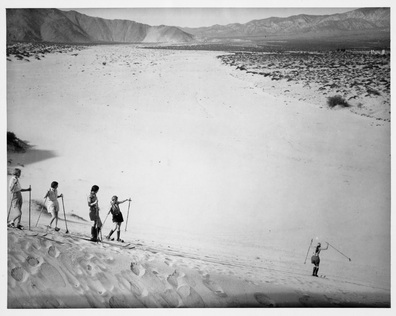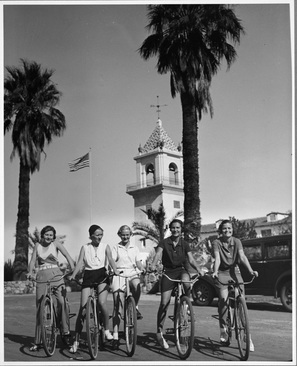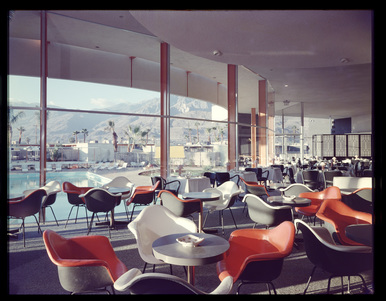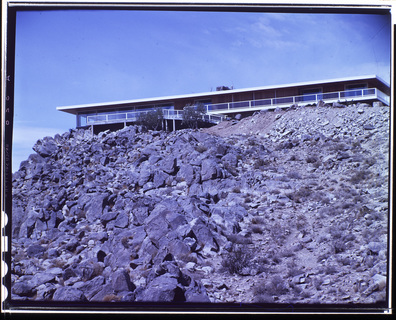Caption information at bottom of page
"The desert's harshness and isolation that had so violently repelled earlier travelers now became the very qualities that so strongly attracted the new sojourners. As the new desert attitudes were disseminated, tourists began coming in ever increasing numbers to experience the re-discovered world"
- Gregg R. Hennessey, "Deserts, Politics, and Culture: The Creation of Anza-Borrego Desert State Park" (1999).
Things to Do During Your Stay
A Guide to Desert Recreation and Leisure
 Sand skiing, Palm Springs, California, Riverside County, Undated.
Sand skiing, Palm Springs, California, Riverside County, Undated.
The popularity of desert resorts, health spas, and off-roading sports have successfully transformed the arid landscape's formidable harshness into a thrill seeking adventure. "A place of beauty and joy where you could have thrills that most people only dream about," says an off-roading enthusiast interviewed by Peter S. Aragona and Clinton F. Smith. The desert as a playground for tourists is a relatively recent development. During the early 1900s, two prominent chroniclers of the American desert were businessman and real estate developer Abbot Kinney in his book Forest and Water (1900) and Rutgers University art historian John C. Van Dyke in his book The Desert (1901). Kinney, the famed entrepreneur who developed "Venice-by-the-Sea" or Venice Beach, espoused the dangers of "desertification" on the delicate ecology of Southern California, particularly its forests and waterways. The desert was something to actively combat and an environment not suitable for living. Van Dyke, unlike his contemporary, saw the desert as an environment unmatched in beauty and appeal. Yet for Van Dyke this landscape is a site where visitors encounter tremendous danger and trickery. The constant battle with the elements, the scarcity of water, and disorienting mirages are cause to tread lightly in this arid terrain.
The American desert could not be fathomed as a setting for recreation and leisure without the 1903 book The Land of Little Water by feminist and indigenous rights activist Mary Austin Hunter. Casting off the anxieties of Kinney and Van Dyke, Hunter provides reassurances. The arid landscape was a space for zestful, reparative living that rivaled any Eastern seaboard destination. This gallery explores Hunter's desert, a prime site for leisure and recreation, with an added twist. The title Etiquette generally refers to learned behavior, but specifically here to the disciplining of tourist behavior. To traverse the desert landscape as a care-free or thrill-seeking tourist means that limits are placed on recreation and leisure. This is managed by real estate developers, architects, and hotels and resorts in order to strike an enjoyable balance between the desert as safe and thrilling before becoming potentially deadly. The photographs in this gallery explore the historical development of "desert taste," which had a great impact on tourist activities and modern architecture and design. The photographs all display methods for conditioning the parameters of experiencing the desert, specifically when moving outside the confines of the resort, waiting out the hottest parts of the day, and living permanently in the environment.
The American desert could not be fathomed as a setting for recreation and leisure without the 1903 book The Land of Little Water by feminist and indigenous rights activist Mary Austin Hunter. Casting off the anxieties of Kinney and Van Dyke, Hunter provides reassurances. The arid landscape was a space for zestful, reparative living that rivaled any Eastern seaboard destination. This gallery explores Hunter's desert, a prime site for leisure and recreation, with an added twist. The title Etiquette generally refers to learned behavior, but specifically here to the disciplining of tourist behavior. To traverse the desert landscape as a care-free or thrill-seeking tourist means that limits are placed on recreation and leisure. This is managed by real estate developers, architects, and hotels and resorts in order to strike an enjoyable balance between the desert as safe and thrilling before becoming potentially deadly. The photographs in this gallery explore the historical development of "desert taste," which had a great impact on tourist activities and modern architecture and design. The photographs all display methods for conditioning the parameters of experiencing the desert, specifically when moving outside the confines of the resort, waiting out the hottest parts of the day, and living permanently in the environment.
 El Mirador Hotel, Palm Springs, California, Riverside County, Approximately 1931- 1934.
El Mirador Hotel, Palm Springs, California, Riverside County, Approximately 1931- 1934.
“The newest form of locomotion on the desert. The recent revival of cycling, which has seized the whole nation, was originated at El Mirador in Palm Springs, when this hotel provided six bicycles for its guest’s amusement back in the winter of 1930-31. Photographs, such as this, were sent out to the newspapers and…were responsible for the craze,” advertises the typewritten caption for the photograph, at left, of five women atop their El Mirador Hotel bicycles. This snippet - a clear marketing slogan for the famous, and no longer extant, Palm Springs resort - continues Mary Austin Hunter's need to juxtapose newly founded desert destinations with the popular seaside boardwalks of the East. Images like this were widely dispersed throughout the country. This circulation had the dual effect of putting desert towns like Palm Springs on the map and creating a hotly desired "desert taste" and etiquette. Although hyperbolic, the caption does reference this in its assertion that bicycle recreation at the El Mirador caused a cycling revitalization for the rest of the country. The five women in the 1930s-era photograph confidently mount their bicycles as they embark on a tour of the desert surrounding the El Mirador, which at this point was fairly undeveloped. The hotel's conditioning of a certain type of tourist etiquette was key to how these five women found enjoyment in this once unappealing landscape. Introducing somewhat outmoded forms of recreation, like cycling, became an unexpected addition to the enjoyment of desert locales. Pleasure and fun seem to emanate from the thrill of participating in forms of recreation not originally designed for the desert, seen most strikingly in the group of young women "sand skiing" on the dunes near Palm Springs. These forms of recreation fit perfectly within the logic of desert recreation. Thrill is provided to visitors without it veering too far from the comfort and safety offered by the resort. Cycling and sand skiing condition a form of etiquette that knows the limits between the "civilized" hotel and the inhospitable environment. The resort itself functions as a beacon to guide its desert sojourners from not straying too far. This is exemplified by the El Mirador Hotel's iconic white tower, seen to the back of the five women in the photograph, which purposefully functions as a visual landmark for the desert-worn traveler.
 Ocotillo Lodge, Lounge, Palm Springs, California, Approximately 1957.
Ocotillo Lodge, Lounge, Palm Springs, California, Approximately 1957.
While cycling and sand skiing in the desert were popular recreational pastimes, they could only be enjoyed at times when it was not too hot. Desert leisure is the symbiotic companion to recreation, because it carries the excitement of visiting the desert back into the hotel or resort during the most uncomfortable parts of the day. When Palm Spring's leisure was made iconic in the 1950s and 1960s, it already had a long history as a health and relaxation spot - the original hot springs on the Agua Caliente Indian Reservation. Capitalizing on this history, resorts designed lounges where visitors could find respite from the heat by swimming, eating, drinking, smoking, and gazing at the blazing desert vistas around them. The image at right is an interior shot of the lounge at the Ocotillo Lodge, designed by the well-known Palm Springs architect William Krisel. The photograph, taken in 1957 by Maynard Parker for the periodical House Beautiful, shows a seamless transition between enjoying the outdoors and leisurely staying within the bounds of the resort. The lounge's sleek and simple design is illuminated by a wall of windows that let in the natural desert light. Activities within the lounge can easily move outside by the pool. In both instances, the desert always remains present, because the hotel design simulates an outdoor experience with the added benefit of not having to deal with its inhospitality.
 Newton T. Bass residence, Exterior, Apple Valley, California, Approximately 1960.
Newton T. Bass residence, Exterior, Apple Valley, California, Approximately 1960.
William Krisel, the architect of the Ocotillo Lodge, was a member of a movement in modern architecture called desert modernism. The desert modern architects all developed a distinct style in midcentury Palm Springs working with aesthetics of the arid landscape. Krisel's projects often took him outside the famed resort town, placing him in the company of other "out-of-towner" desert modernists such as Richard Neutra, A. Quincy Jones, John Lautner, and E. Stewart Williams. The desert terrain of Palm Springs inspired architecture because the landscape was a prime setting for showcasing modern design. The harsh sunlight, creating a dramatic contrast between light and shadow, accentuates the clean, simple, and largely geometric structures designed by these architects. The extremes found in the natural environment are harnessed by desert modernist buildings. William Krisel's design philosophy sought to disintegrate the boundaries between indoor and outdoor space, seen in the Ocotillo Lodge lounge. The image at right is a exterior photograph of the Newton T. Bass residence, commonly called "Hilltop House." Designed by architect Francisco Artigas, it is an example of a desert modernist design that traveled outside of Palm Springs. Because the flat roof line is parallel to its interior levels, light hitting the top and exterior supports of the structure begin to glisten, while the interior spaces remain dark. The residence seems to consist entirely of light and shadow hovering ever so slightly above the rock face underneath. Desert modernism does not however seek to overpower the landscape, but rather amplify its geometry and tonal gradations. This architecture continues the objectives of the Palm Springs resorts, but now with an interest in using modern desert taste to make living spaces. The desert modernists did not create structures completely alien to their settings. Rather they made them appear, through the power of design, just as natural as the environment around it.
|
Tour
|
Caption Information
- Sand skiing, Palm Springs, California, Riverside County, undated, 310 (3975), The Eugene Swarzwald Pictorial California and the Pacific Collection of Photographs, The Huntington Library, San Marino, California.
- El Mirador Hotel and San Jacinto Mountains, Palm Springs, California, Riverside County, approximately 1931- 1934, 310 (3903), The Eugene Swarzwald Pictorial California and the Pacific Collection of Photographs, The Huntington Library, San Marino, California.
- El Mirador Hotel, Palm Springs, California, Riverside County, approximately 1931- 1934, 310 (3916), The Eugene Swarzwald Pictorial California and the Pacific Collection of Photographs, The Huntington Library, San Marino, California.
- Wilbur Clark’s Desert Inn, Exterior, Las Vegas, Nevada, undated, 310 (7651), The Eugene Swarzwald Pictorial California and the Pacific Collection of Photographs, The Huntington Library, San Marino, California.
- Tennis Club, Palm Springs, California, Riverside County, approximately 1960s, 310 (3963), The Eugene Swarzwald Pictorial California and the Pacific Collection of Photographs, The Huntington Library, San Marino, California.
- Pool and Dining at the Canyon Hotel, Palm Springs, California, Riverside County, approximately 1960s, 310 (3965), The Eugene Swarzwald Pictorial California and the Pacific Collection of Photographs, The Huntington Library, San Marino, California.
- Ocotillo Lodge, Exterior, Palm Springs, California, approximately 1957, photCl MLP 0945 (007), The Maynard L. Parker Negatives, Photographs, and Other Material, The Huntington Library, San Marino, California.
- Ocotillo Lodge, Lounge, Palm Springs, California, approximately 1957, 0945 (010), The Maynard L. Parker Negatives, Photographs, and Other Material, The Huntington Library, San Marino, California.
- Taliesin West, Architectural detail, Scottsdale, Arizona, approximately 1940s, photCL MLP 1587 (039), The Maynard L. Parker Negatives, Photographs, and Other Material, The Huntington Library, San Marino, California.
- Newton T. Bass residence, Exterior, Apple Valley, California, approximately 1960, photCL MLP 0035 (040), The Maynard L. Parker Negatives, Photographs, and Other Material, The Huntington Library, San Marino, California.